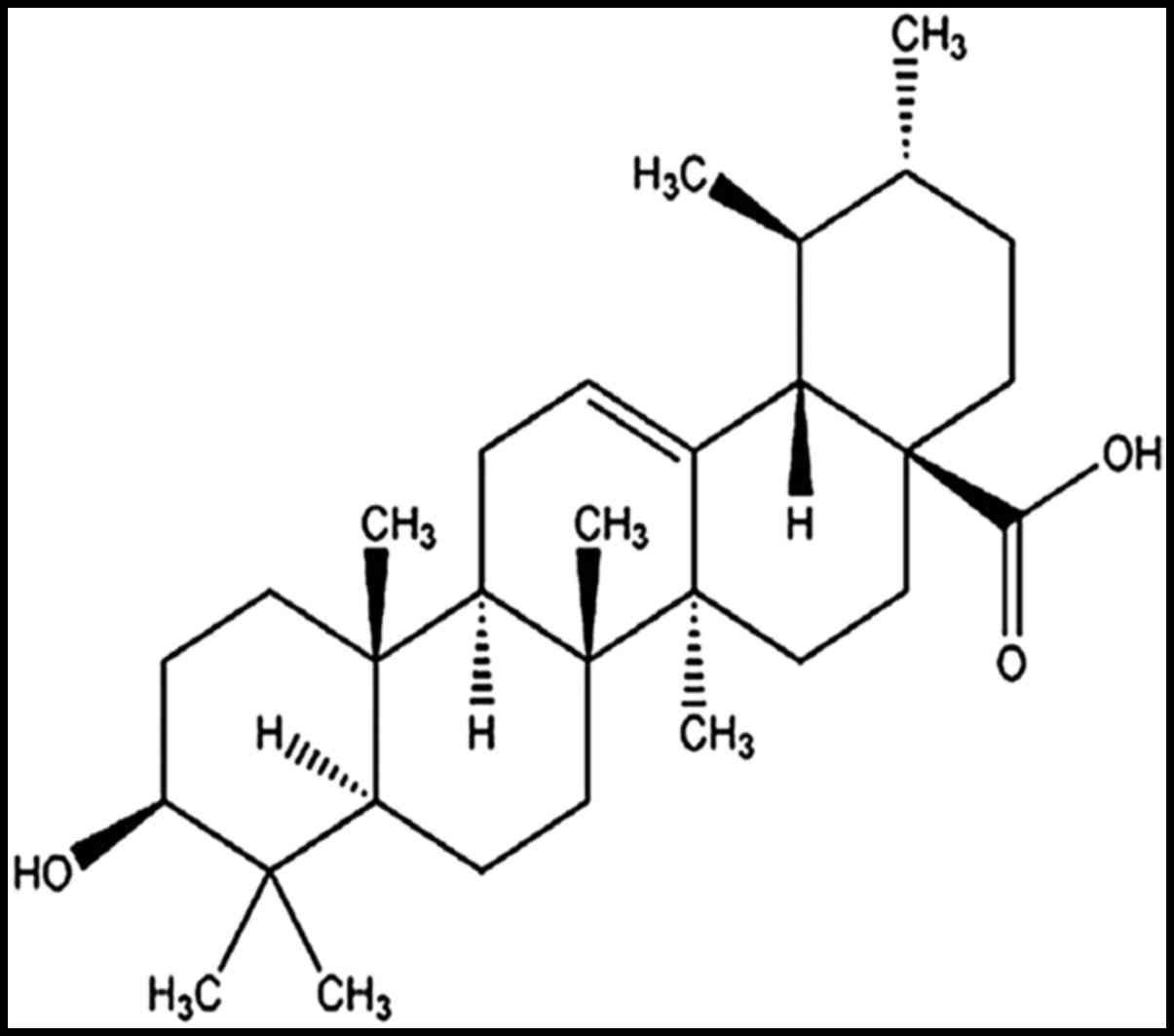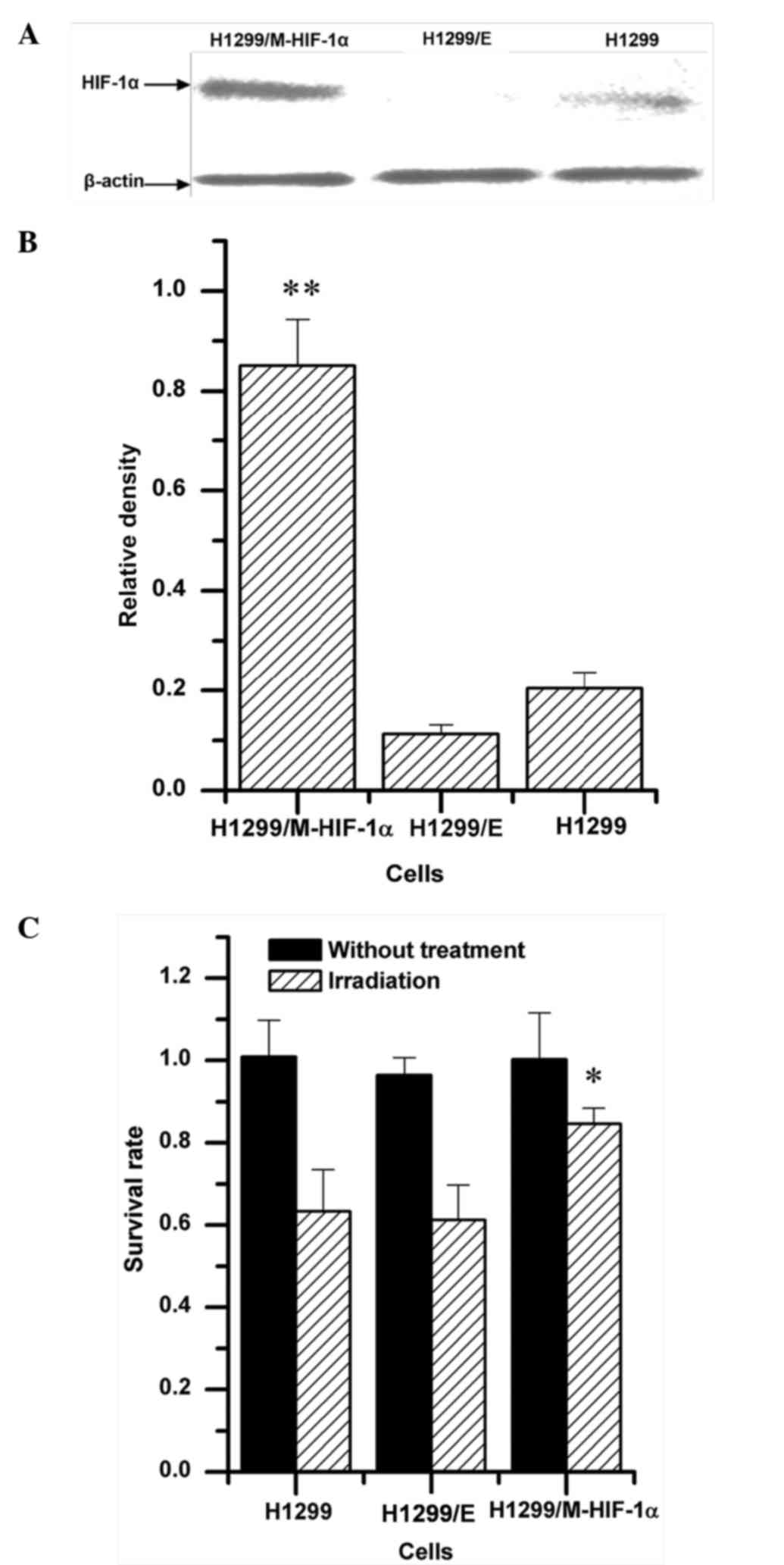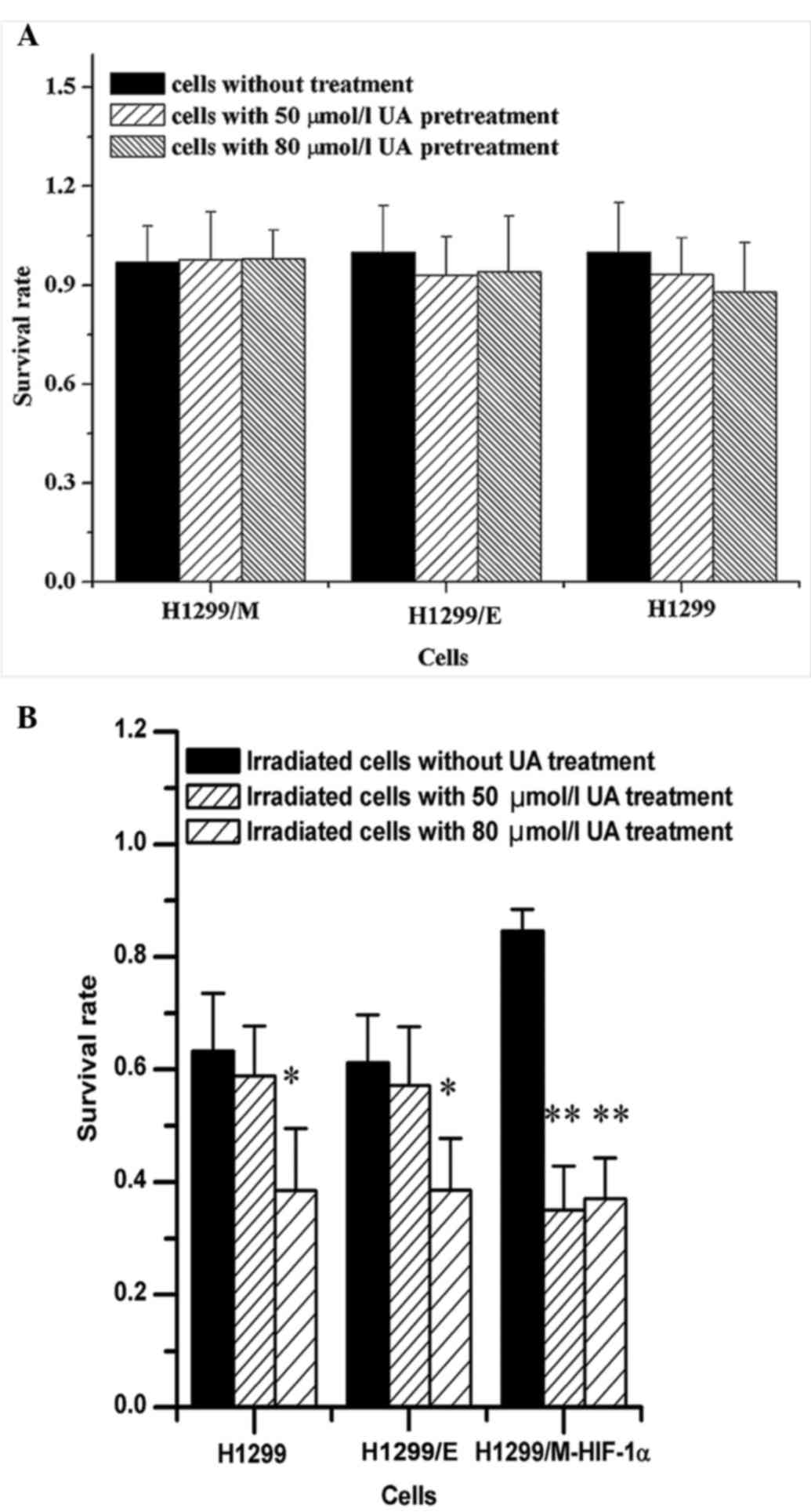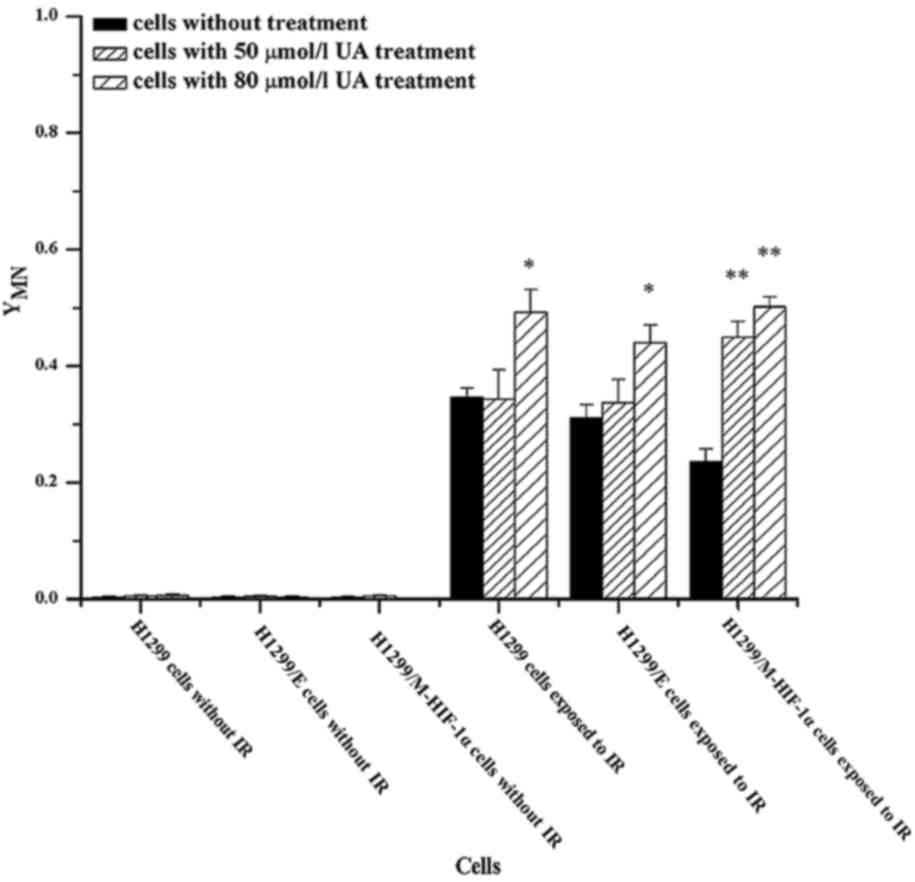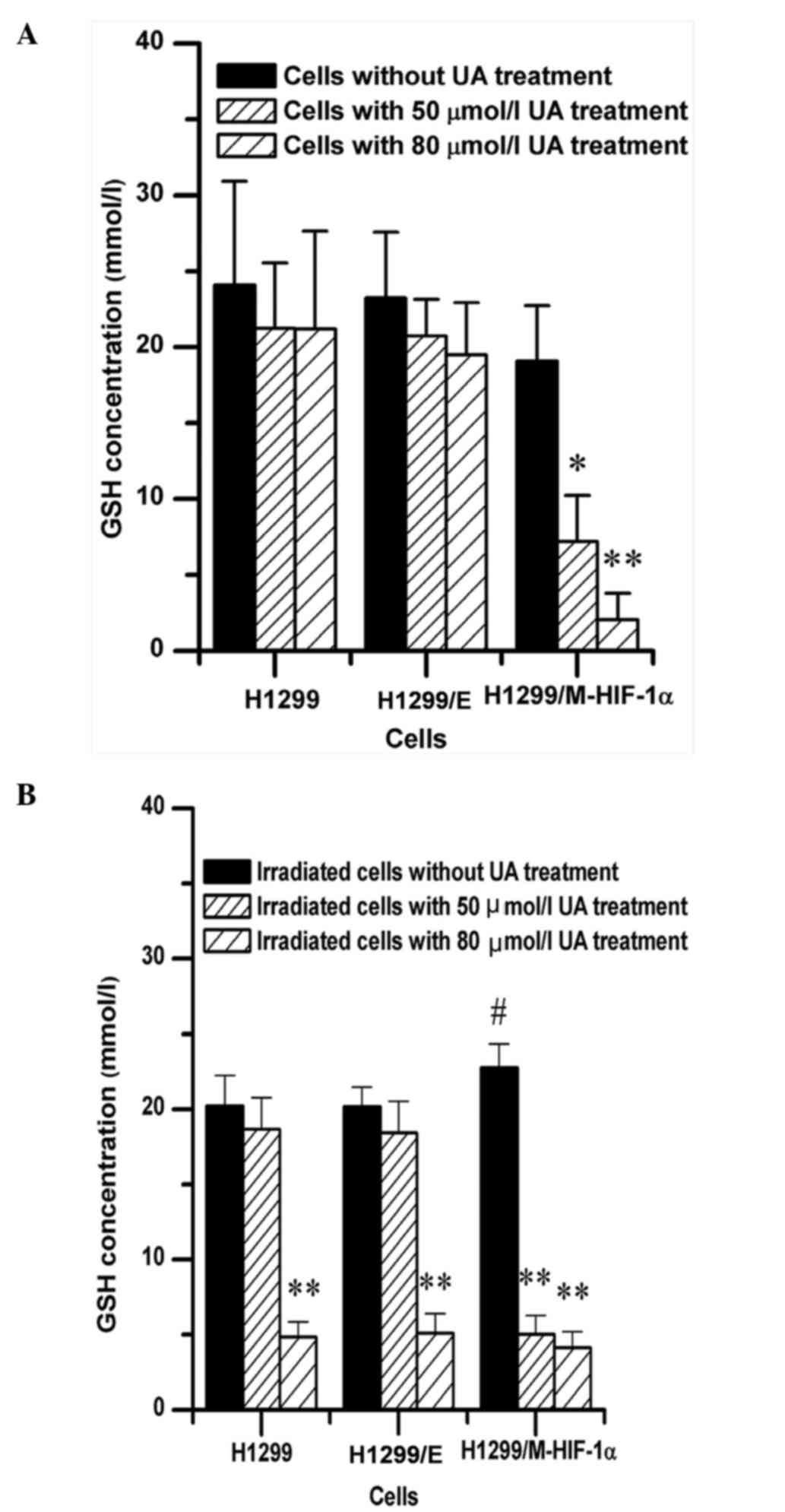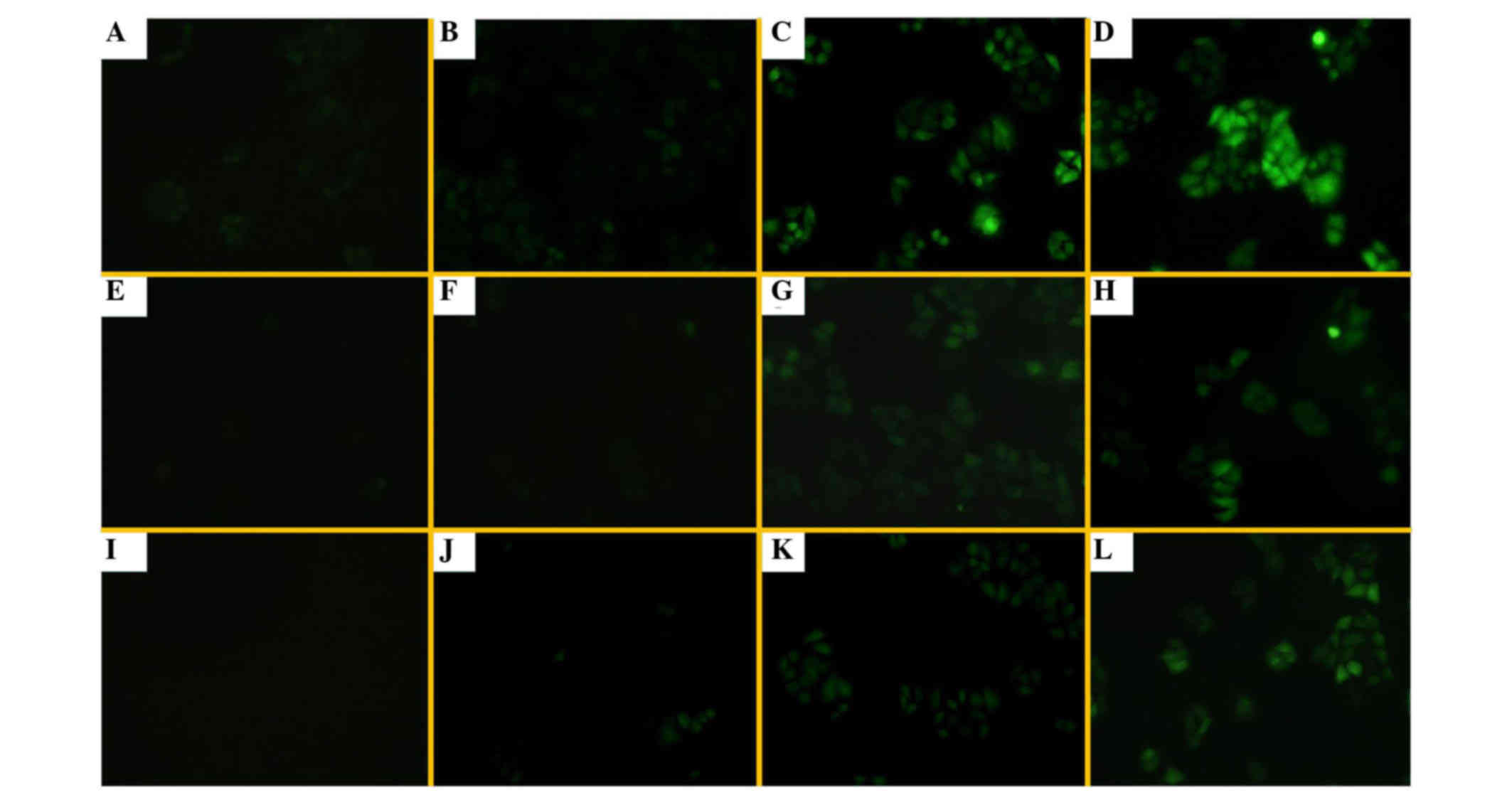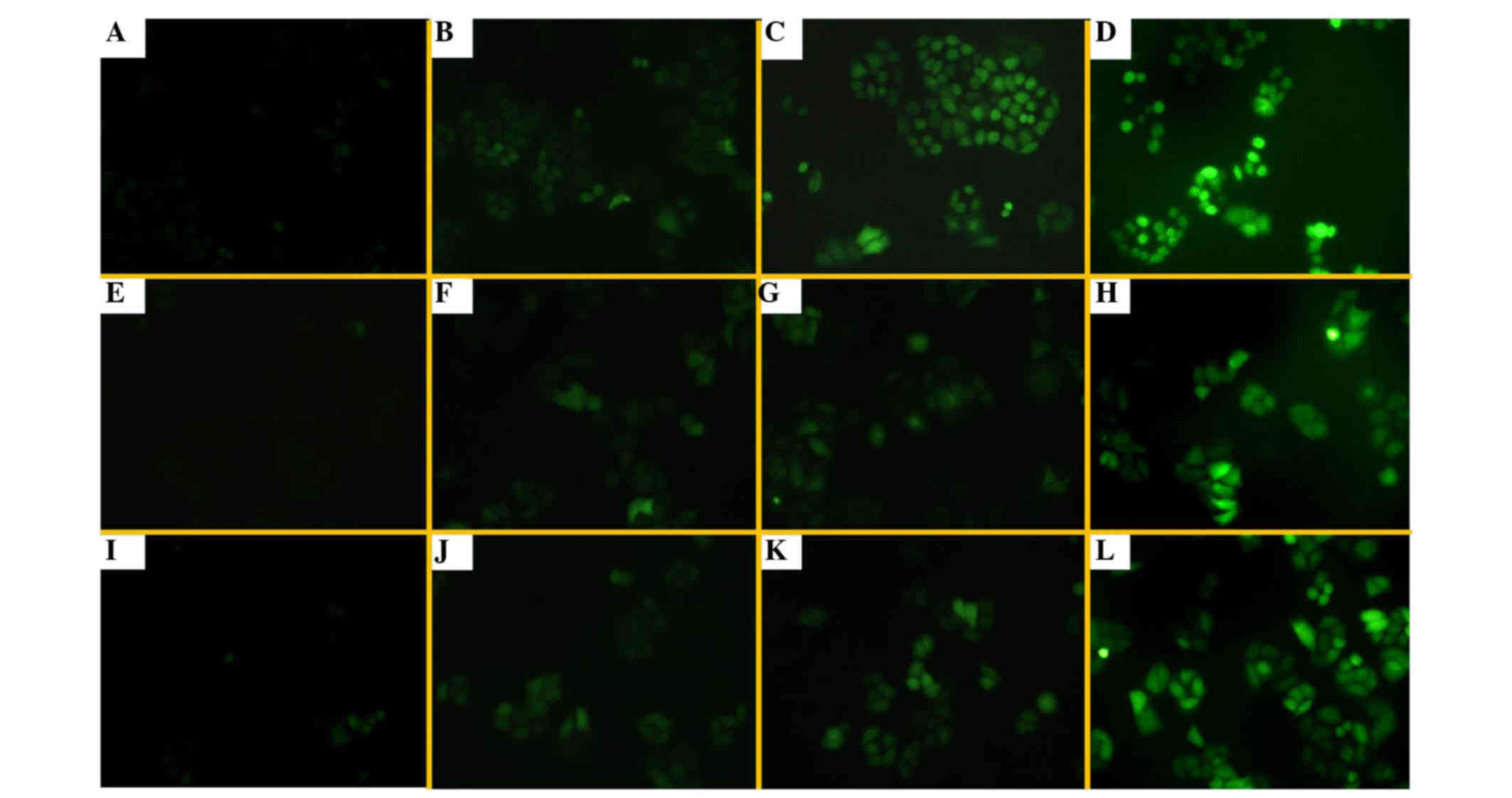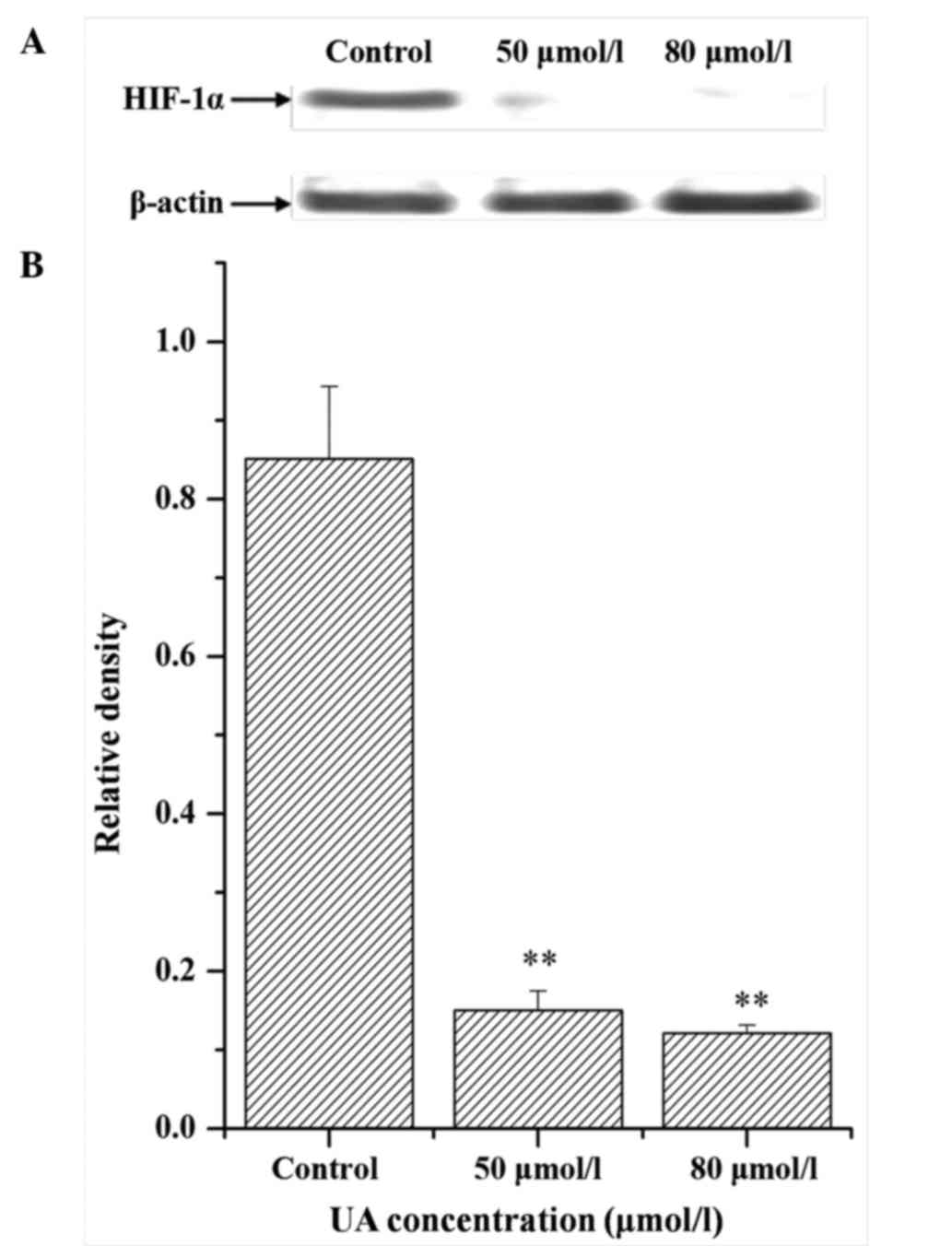Ursolic acid sensitizes radioresistant NSCLC cells expressing HIF‑1α through reducing endogenous GSH and inhibiting HIF‑1α
- Authors:
- Published online on: December 7, 2016 https://doi.org/10.3892/ol.2016.5468
- Pages: 754-762
-
Copyright: © Song et al. This is an open access article distributed under the terms of Creative Commons Attribution License.
Abstract
Introduction
Radiotherapy is an established treatment modality for non-small cell lung cancer (NSCLC), which can provide an effective cure for a proportion of patients (1). Although NSCLC is a moderately radiation-responsive tumor, local control is still not achieved in numerous patients, primarily due to intrinsic and acquired resistance of tumor cells to ionizing radiation (2,3). There are difficulties in delivering sufficiently high radiotherapy doses to the tumor due to potential toxicity development in the normal tissue (4). Therefore, it is particularly beneficial for radiotherapy of NSCLC to increase the radiosensitivity of resistant NSCLC cells by using natural or synthetic compounds.
Local failure of radiotherapy is associated with a series of factors, where the radiosensitivity of irradiated cells depends on a complex interplay of nuclear and cytoplasmic signaling cascades (5–8). Ionizing radiation induces DNA double-strand breakages (DSBs) and production of free radicals (FRs) and reactive oxygen species (ROS), which can cause DSBs of DNA and lipid oxidation of the cellular membrane; these events are widely acknowledged as the principal determinants of radiation-induced cell death (9,10). Intracellular antioxidants such as the tripeptide thiol L-γ-glutamyl-L-cysteinyl-glycine (glutathione, GSH) play a key role in the protection of cells against the oxidative stress induced by FR and ROS (11). GSH, which is present in all mammalian cells, is the most important intracellular thiol-based scavenger of FR and ROS (12–14). The level of GSH is increased in various tumor cells, including NSCLC cells (15,16). Agents that decrease the cellular content of GSH could effectively inhibit the DNA damage repair to increase the response of tumor cells to ionizing radiation (17,18).
Numerous compounds extracted from natural sources have been observed to elevate the radiosensitivity of tumor cells (19,20). Ursolic acid (3-beta-hydroxy-urs-12-en-28-oic acid, UA) is one of the pentacyclic triterpenoids that exist widely in the plant kingdom (Fig. 1) (21). UA is a compound of interest in oncology research due to its cytotoxicity, its anti-invasive and anti-migration activities, and its ability to induce cell differentiation (22,23). UA also interferes with damage repair of cancer cells and induces apoptosis in cancer cells by regulating different signaling pathways, including inhibition of Wnt/β-catenin and activation of the c-Jun N-terminal kinase and the phosphoinositide 3-kinase/Akt/nuclear factor (NF)-κB signaling pathways (24–26). Previous studies have demonstrated sensitization caused by UA towards chemotherapy and radiotherapy (27–29). With regard to the treatment of NSCLC, chemosensitization to low doses of UA was found in the ASTC-a-1 cell line (human lung adenocarcinoma cells) through suppression of NF-κB (27). However, it remains unclear whether the radiosensitivity of NSCLC cells, particularly that of cells with refractory response to radiation, could be increased by UA. In present study, a radioresistant NSCLC cell line was established by transfecting a mutant HIF-1α (M-HIF-1α) plasmid, and the radiosensitivity of the parental and radioresistant NSCLC cells was investigated upon UA pretreatment. In order to preliminarily analyze the mechanism, the alteration of intracellular GSH level was also analyzed.
Materials and methods
Cell culture and treatment
The human lung cancer H1299 cell line was kindly provided by Professor Qinghua Shi (College of Biological Science, University of Science and Technology of China, Hefei, China). Cells were maintained in Dulbecco's modified Eagle medium (Gibco; Thermo Fisher Scientific, Inc., Waltham, MA, USA) supplemented with 10% fetal bovine serum (Gibco; Thermo Fisher Scientific, Inc.), penicillin (100 U/ml) and streptomycin (100 µg/ml) (Sigma-Aldrich, St. Louis, MO, USA) at 37°C in an incubator containing a humid atmosphere of 95% air and 5% CO2, and propagated according to the protocol supplied by the American Type Culture Collection (Manassas, VA, USA). UA was purchased from Nanjing Zelang Medical Technology Co., Ltd. (Nanjing, China), dissolved in dimethyl sulfoxide (DMSO; Sigma-Aldrich) at a stock concentration of 5 mmol/l and stored at −20°C.
Plasmids and transfection assays
The pcDNA3.0 vector with enhanced green fluorescence protein (EGFP) was kindly provided by Professor Qinghua Shi. HIF-1α complementary DNA (cDNA) for with three mutant motifs, including the prolines at the 402 and 564 sites in the oxygen-dependent degradation domain (ODDD) of HIF-1α, and the aspartic acid at the 803 site in the C-terminal transactivation domain (CTAD) of HIF-1α, was purchased from Beijing Zhongyuan Ltd. (Beijing, China). The M-HIF-1α cDNA was cloned into the pcDNA3.0-EGFP vector to construct the pcDNA3.0-EGFP-HIF-1α recombinant plasmid. The pcDNA3.0-EGFP empty vector was used as control. H1299 cells (5×105) were transfected with 4 µg plasmid DNA using Lipofectamine 2000 (Invitrogen; Thermo Fisher Scientific, Inc.), according to the manufacturer's protocol. The neomycin-resistant clones were selected in DMEM (Gibco; Thermo Fisher Scientific, Inc.) containing 500 µg/ml G418 (Promega Corporation, Madison, WI, USA), and transferred into a 24-well culture plate with cloning discs (Sigma-Aldrich). The selected clones were expanded in medium containing 200 µg/ml G418, and identified by detecting the messenger RNA and protein expression of M-HIF-1α.
Cell viability assay
The influence of UA on cell growth was determined using the MTT (Sigma-Aldrich) assay. The parental H1299 cells and H1299 cells expressing the M-HIF-1α fragment were seeded in 96-well plates at a density of 5×103 cells/well, and then treated with various concentrations of UA for 24 h. Next, the medium was replaced with fresh medium to allow cells to continuously grow for 72 h. MTT dye was then added to a final concentration of 50 mg/ml, and the cells were subsequently incubated for additional 4 h at 37°C. The medium containing residual MTT dye was carefully aspirated from each of the wells, and 200 µl dimethyl sulfoxide was added to each well to dissolve the reduced formazan dye. The survival rates of viable cells were calculated by comparing the optical absorbance of the culture exposed to UA treatment with that of the untreated control.
Irradiation
Irradiation was emitted using a 6 MV X-ray linear accelerator (Varian Inc., Palo Alto, CA, USA) at a dose rate of 250 cGy/min.
Micronucleus (MN) assay
MN frequencies were tested with the cytokinesis-block technique as a biological end point for the response of mimetic hypoxia to irradiation (30). Briefly, the cells were exposed to 0.83 µg/ml cytochalasin B (Sigma-Aldrich) for 19–20 h, followed by 75 mM KCl hypotonic treatment for 1–3 min, and then fixed in situ with methanol:acetic acid (9:1 v/v) for 30 min. Air-dried cells were stained with 5% Giemsa for 10 min. MN were scored in binucleated cells, and the formation of binucleated cells was measured as the percentage of the total number of cells scored. For each sample, ≥1,000 binucleated cells were counted. The MN yield was calculated as the ratio of the number of MN to the number of binucleated cells scored.
Western blot analysis of HIF-1α expression
Cells subjected to different treatments were scraped off from culture flasks and lysed in lysis buffer containing 10% glycerol, 10 mM Tris-HCl (pH 6.8), 1% sodium dodecyl sulfate (SDS), 5 mM dithiothreitol and 1X complete protease inhibitor cocktail (Sigma-Aldrich). The Bradford method was used to detect concentrations of protein in diverse samples. Protein concentration was measured using an automatic multifunctional microplate reader. Proteins (50 µg) were separated by 8% SDS-polyacrylamide gel electrophoresis. The separated proteins were electrophoretically transferred to polyvinylidene difluoride membranes, which were then blocked with 5% skim milk in Tris-buffered saline containing 0.1% Tween 20 at room temperature for 1 h, and then incubated with mouse anti-HIF-1α antibody (catalog no. ab82832; Abcam, Cambridge, MA, USA) at a 1:500 dilution overnight at 4°C, followed by goat anti-mouse immunoglobulin G (catalog no. ab8226; Abcam) for 1 h at room temperature. Signals were detected with enhanced chemiluminescence (ECL Plus; GE Healthcare Life Sciences, Chalfont, UK). An antibody against the microtubule protein tubulin (anti-tubulin; Abcam) at a 1:1,000 dilution was used as an internal control to observe the changes in the HIF-1α bands.
Intracellular GSH assay
Following the treatment of triplicate samples of 106 cells with different reagents, the intracellular GSH content was measured with a glutathione reductase/5,5′-dithiobis-(2-nitrobenzoic acid) (DTNB) recycling assay kit obtained from Nanjing Jiancheng Bioengineering Research Institute (Nanjing, China), following the protocol recommended by the manufacturer. Briefly, GSH was determined using a reaction mixture containing 50 µl of cell lysates, 50 µl of 2.4 mM DTNB and 50 µl of 10.64 mU/µl glutathione reductase in the assay buffer (153 mM sodium phosphate and 8.4 mM ethylenediaminetetraacetic acid, pH 7.5). After 5 min incubation at 25°C, the reaction was started by the addition of 50 µl of reduced nicotinamide adenine dinucleotide phosphate (NADPH) solution (0.16 mg/ml) in the assay buffer. The standard and the sample cuvettes were placed into a dual-beam spectrophotometer, and the increases in absorbance at 412 nm were followed as a function of time.
Measurement of intracellular ROS
Cell suspension from the different treatmentswas incubated with 10 µM of 2′,7′-dichloro-dihydro-fluorescein diacetate (DCFH-DA) for 30 min, and then washed three times with phosphate-buffered saline for removing excess DCFH probe. Upon counting the viable cells, the fluorescence intensities of the cells were observed under an inverted fluorescence microscope (Nikon Corporation, Tokyo, Japan), at excitation and emission wavelengths of 488 and 525 nm, respectively.
Statistical analysis
Data are reported as the mean ± standard error of the mean of three separate experiments unless stated otherwise. Statistical significance was measured by independent samples t-test and analysis of variance. P<0.05 was considered to indicate a statistically significant difference.
Results
Identification of radioresistant NSCLC cells
The radiosensitivity of H1299 cells was regulated by transfecting recombinant pcDNA3.0-EGFP-HIF-1α plasmid. As shown in Fig. 2A and B, under aerobic conditions, overexpression of HIF-1α was detected in H1299 cells transfected with the H1299/M-HIF-1α recombinant plasmid, named H1299/M-HIF-1α cells. Both the parental H1299 cells and the H1299 cells transfected with empty vector (H1299/E cells) exhibited loss of HIF-1α expression. Upon exposure to 2 Gy irradiation, cellular viability was significantly upregulated in H1299/M-HIF-1α cells compared with that in H1299 and H1299/E cells (Fig. 2C). By contrast, no obvious difference was observed between H1299 cells and H1299/E cells. It was therefore demonstrated that H1299/M-HIF-1α cells had lower radiosensitivity than H1299 cells and H1299/E cells.
Influence of UA on the sensitivity of resistant NSCLC cells
To evaluate the radiosensitizing effect of UA on NSCLC cells, the experimental concentration of UA was first selected. The result from the cytotoxicity test indicated that there were not significant changes in the survival rates of the three types of NSCLC cells pretreated with UA at 50 and 80 µmol/l, as shown in Fig. 3A. Alterations in the survival rates of the cells subjected to treatment with two different concentrations of UA for 24 h were detected upon irradiation at 2 Gy. It was observed that UA at two different concentrations could significantly increase the radiosensitivity of H1299/M-HIF-1α cells, leading to the reduction of survival rates of the irradiated cells. However, the radiosensitizing effects of UA on H1299 and H1299/E cells were only observed at high concentration (80 µmol/l) (Fig. 3B). Consequently, it was demonstrated that radioresistant NSCLC cells were the most sensitive to the UA treatment combined with irradiation.
Alteration of MN formation in irradiated NSCLC cells by UA treatment
The MN frequencies in irradiated cells were further measured for the assessment of DNA damage. As shown in Fig. 4, when NSCLC cells were not exposed to ionizing radiation, the intracellular MN frequencies were very low, even with UA pretreatment. Conversely, the MN ratio increased in irradiated cells. Subsequently, the addition of UA at 50 and 80 µmol/l could further increase the formation of MN in irradiated H1299/M-HIF-1α cells. Further elevation of MN frequencies, however, was not observed in H1299 or H1299/E cells subjected to the combination treatment of UA at 50 µmol/l concentration and radiation. It was thus obvious that UA effectively promoted the formation of MN in irradiated NSCLC cells, particularly in irradiated H1299/M-HIF-1α cells.
Changes in intracellular GSH content by UA treatment
Due to the strong radioprotection of endogenous GSH, the intracellular GSH content was analyzed in NSCLC cells upon non-exposure or exposure to irradiation following UA pretreatment. The results revealed that UA could remarkably decrease the endogenous GSH content in H1299/M-HIF-1α cells not exposed to radiation but not in H1299 or H1299/E cells, as shown in Fig. 5A. Additionally, following NSCLC cells exposure to irradiation, the level of cellular GSH in H1299/M-HIF-1α cells was higher than that in H1299 cell and H1299/E cells, as shown in Fig. 5B. Furthermore, UA at high concentration (80 µmol/l) could effectively attenuate the intracellular GSH content of H1299 and H1299/E cells. The combination treatment of UA with radiation could decrease the GSH intracellular contents in H1299/M-HIF-1α cells, both at 50 and 80 µmol/l concentration of UA.
Alteration of intracellular ROS levels by UA treatment
Under an inverted fluorescence microscope, there was fluorescence in H1299/E and H1299/M-HIF-1α cells without DCFH-DA probe treatment, due to the presence of EGFP in the transfected plasmid (Fig. 6A and E). The fluorescence intensities in the three groups of cells evaluated were weakly increased following DCFH-DA treatment. UA at different concentrations could enhance the levels of intracellular ROS and FR in these cells, particularly in H1299/M-HIF-1α cells (Fig. 6). The results shown in Fig. 7 further demonstrate that the combination of UA with radiation treatment significantly enhanced the generation of ROS and FR. It was revealed that UA with or without irradiation could promote an increase in cellular ROS and FR, particularly in H1299/M-HIF-1α cells.
Influence of UA on the expression of HIF-1α
Besides detection of intracellular GSH, the levels of HIF-1α in radioresistant cells were investigated upon UA pretreatment. It was observed that UA at different concentrations markedly reduced the protein expression levels of HIF-1α, as detected by western blotting (Fig. 8). The results also revealed that UA could suppress the expression of M-HIF-1α.
Discussion
In our previous study, it was observed that oleanolic acid (OA), an isomer of UA, could effectively increase the radiosensitivity of aerobic and hypoxic A549 cells, a NSCLC cell line, by inhibition of intracellular GSH synthesis and HIF-1α expression (31,32). The radiosensitizing efficiency of UA on NSCLC cells, particularly on radioresistant cells, was also observed in the present study, due to the higher anti-tumor activity of UA compared with that of OA (33). In the current study, a radioresistant cell line was firstly established by transfection with an M-HIF-1α plasmid. It is known that HIF-1α is closely associated with the radiosensitivity of tumor cells, including NSCLC cells (34,35). Numerous studies have shown that, following inhibition of the master transcription factor triggered in response to hypoxia, the radiotherapeutic effect on NSCLC may be significantly increased (36,37). Under aerobic conditions, HIF-1α is hydroxylated by prolyl hydroxylases at the proline residues 402 and 564 in the ODDD (38). Subsequently, it is targeted for proteasome-mediated degradation via a protein ubiquitin ligase complex containing the product of von Hippel-Lindau tumor suppressor (39). Another blockage pathway of HIF-1α activity is hydroxylation of asparagine 803 by factor inhibiting HIF-1 within the CTAD, followed by interruption of the binding of HIF-1α to the p300/CREB-binding protein coactivator, thus preventing the transactivation capabilities of HIF-1 (40). In the present study, the cDNA of HIF-1α within the pcDNA3.0-EGFP-HIF-1α recombinant plasmid contained three mutant sites, namely proline residues 402 and 564, and asparagine 803, which enable HIF-1α to evade hydroxylation by maintaining HIF-1α expression and transcriptional activity under aerobic conditions. Thus, H1299/M-HIF-1α cells exhibited high level of HIF-1α under aerobic conditions, concomitant with a refractory response to radiation (41). This in vitro model is convenient to observe alteration of the sensitivity of resistant cells to radiation, as HIF-1α need not be induced by physical or chemical hypoxia.
As a natural antitumor drug, the activity of UA has been reported in numerous studies (22,23,42). Previous data reported the sensitization of cancer cells to ionizing radiation-induced apoptosis by UA, including human prostate cancer DU145 cells, mouse colon cancer CT26 cells and mouse melanoma B16F10 cells (28). The present study demonstrated that UA exerted a similar radiosensitizing effect on NSCLC cells. Notably, a stronger sensitizing effect of UA was observed on radioresistant H1299 cells with high level of HIF-1α expression compared with that observed in H1299 cells without HIF-1α expression. Similarly, sensitization to ionizing radiation of radioresistant tumor cells was previously observed to be effected by other natural or synthetic compounds (43,44). For instance, Biddlestone-Thorpe et al (43) reported that glioma cells with a mutant p53 gene that induced tolerance to radiation were markedly more sensitive to radiosensitization induced by KU-60019 (an ataxia telangiectasia mutated kinase inhibitor) than genetically matched wild-type glioma cells. The mechanism could be associated with changes in the expression of various genes and modification of intracellular homeostasis.
There are numerous studies demonstrating that the numbers and frequencies of intracellular MN represent DNA damage induced by radiation; thus MN is considered as an appropriate biological tool to evaluate in vitro radiosensitivity due to its high reliability and reproducibility (45–47). Based on the results of the present cell viability assay, intracellular MN frequencies were detected as a biomarker of DNA damage caused by ionizing radiation. The results revealed that the intracellular MN formation was in agreement with the change in tendency observed in the cell viability assay. Both 50 and 80 µmol/l of UA could increase the MN frequencies in binucleated H1299/M-HIF-1α cells following irradiation. By contrast, elevation of MN formation in irradiated H1299 cells and H1299/E cells was only observed with a UA concentration of 80 µmol/l. These findings indicate the marked sensitization caused by UA on radioresistant NSCLC cells.
According to previous studies, the depletion of GSH content strongly resulted in the production of cellular MN and the death of irradiated NSCLC cells by increasing the levels of cellular ROS and FR (31,32,48). Thus, the present study measured the intracellular GSH content and the levels of ROS and FR through either UA treatment alone or combination treatment with UA and irradiation. The results indicated that treatment of UA alone decreased the GSH content and increased the levels of ROS and FR in H1299/M-HIF-1α cells, but not in H1299 cells or H1299/E cells, whereas the combination of UA at high concentration (80 µmol/l) and irradiation could diminish the GSH content and increase the levels of ROS and FR in H1299 cells and H1299/E cells. For H1299/M-HIF-1α cells, either exposed to irradiation or not, there was a reduction in cellular GSH content, concomitant with an enhancement in ROS and FR, following treatment with UA at various concentrations. To explore the mechanism behind these observations, the expression of HIF-1α in H1299/M-HIF-1α cells was detected upon UA treatment. It was observed that increasing HIF-1α expression was inhibited by UA, which is in agreement with previously reported data (49,50). According to the study by Guo et al (51), the inhibition of HIF-1α could decrease the cellular GSH content and increase the generation of ROS by regulating the level of NADPH, which led to a more oxidizing environment for the cells. In present study, the GSH content of H1299/M-HIF-1α cells could further be reduced due to UA-mediated suppression of HIF-1α expression. Therefore, the increased sensitization of H1299/M-HIF-1α cells by UA was associated with reduced HIF-1α expression.
In summary, the present results demonstrated that UA significantly exerted a radiosensitizing effect on NSCLC cells, particularly on radioresistant cells overexpressing HIF-1α. The primary mechanism is explained as follows: i) Radiosensitivity of NSCLC cells without HIF-1α expression was upregulated through UA, which decreased the intracellular GSH content; and ii) two pathways, including the attenuation of GSH and the suppression of HIF-1α by UA, enhanced the sensitization towards ionizing radiation-induced cell death of NSCLC cells overexpressing HIF-1α. UA should therefore be deeply studied as a potential radiosensitizing reagent for NSCLC radiotherapy.
Acknowledgements
The present study was funded by the Anhui Provincial Natural Science Foundation of China (Hefei, China; grant no. 11040606M210).
References
|
Senthi S, Haasbeek CJ, Slotman BJ and Senan S: Outcomes of stereotactic ablative radiotherapy for central lung tumours: A systematic review. Radiother Oncol. 106:276–282. 2013. View Article : Google Scholar : PubMed/NCBI | |
|
Shen Z, Wu X, Wang Z, Li B and Zhu X: Effect of miR-18a overexpression on the radiosensitivity of non-small cell lung cancer. Int J Clin Exp Pathol. 8:643–648. 2015.PubMed/NCBI | |
|
Subtil FS, Wilhelm J, Bill V, Westholt N, Rudolph S, Fischer J, Scheel S, Seay U, Fournier C, Taucher-Scholz G, et al: Carbon ion radiotherapy of human lung cancer attenuates HIF-1 signaling and acts with considerably enhanced therape-utic efficiency. FASEB J. 28:1412–1421. 2014. View Article : Google Scholar : PubMed/NCBI | |
|
Cannon DM, Mehta MP, Adkison JB, Khuntia D, Traynor AM, Tomé WA, Chappell RJ, Tolakanahalli R, Mohindra P, Bentzen SM and Cannon GM: Dose-limiting toxicity after hypofractionated dose-escalated radiotherapy in non-small-cell lung cancer. J Clin Oncol. 31:4343–4348. 2013. View Article : Google Scholar : PubMed/NCBI | |
|
Kim E, Youn H, Kwon T, Son B, Kang J, Yang HJ, Seong KM, Kim W and Youn B: PAK1 tyrosine phosphorylation is required to induce epithelial-mesenchymal transition and radioresistance in lung cancer cells. Cancer Res. 74:5520–5531. 2014. View Article : Google Scholar : PubMed/NCBI | |
|
Sekhar KR, Benamar M, Venkateswaran A, Sasi S, Penthala NR, Crooks PA, Crooks PA, Hann SR, Geng L, Balusu R, et al: Targeting nucleophosmin 1 represents a rational strategy for radiationsensitization. Int J Radiat Oncol Biol Phys. 89:1106–1114. 2014. View Article : Google Scholar : PubMed/NCBI | |
|
Theys J, Yahyanejad S, Habets R, Span P, Dubois L, Paesmans K, Kattenbeld B, Cleutjens J, Groot AJ, Schuurbiers OC, et al: High NOTCH activity induces radiation resistance in non small cell lung cancer. Radiother Oncol. 108:440–445. 2013. View Article : Google Scholar : PubMed/NCBI | |
|
Okaichi K, Nose K, Kotake T, Izumi N and Kudo T: Phosphorylation of p53 modifies sensitivity to ionizing radiation. Anticancer Res. 31:2255–2258. 2011.PubMed/NCBI | |
|
Jamal M, Rath BH, Williams ES, Camphausen K and Tofilon PJ: Microenvironmental regulation of glioblastoma radioresponse. Clin Cancer Res. 16:6049–6059. 2010. View Article : Google Scholar : PubMed/NCBI | |
|
Ayouaz A, Raynaud C, Heride C, Revaud D and Sabatier L: Telomeres: Hallmarks of radiosensitivity. Biochimie. 90:60–72. 2008. View Article : Google Scholar : PubMed/NCBI | |
|
Quintana-Cabrera R and Bolaños JP: Glutathione and γ-glutamylcysteine in the antioxidant and survival functions of mitochondria. Biochem Soc Trans. 41:106–110. 2013. View Article : Google Scholar : PubMed/NCBI | |
|
Pereira CV, Nadanaciva S, Oliveira PJ and Will Y: The contribution of oxidative stress to drug-induced organ toxicity and its detection in vitro and in vivo. Expert Opin Drug Metab Toxicol. 8:219–237. 2012. View Article : Google Scholar : PubMed/NCBI | |
|
Slemmer JE, Shacka JJ, Sweeney MI and Weber JT: Antioxidants and free radical scavengers for the treatment of stroke, traumatic brain injury and aging. Curr Med Chem. 15:404–414. 2008. View Article : Google Scholar : PubMed/NCBI | |
|
Wells PG, Bhuller Y, Chen CS, Jeng W, Kasapinovic S, Kennedy JC, Kim PM, Laposa RR, McCallum GP, Nicol CJ, et al: Molecular and biochemical mechanisms in teratogenesis involving reactive oxygen species. Toxicol Appl Pharmacol 207 (2 Suppl). 354–366. 2005. View Article : Google Scholar | |
|
Ogunrinu TA and Sontheimer H: Hypoxia increases the dependence of glioma cells on glutathione. J Biol Chem. 285:37716–37724. 2010. View Article : Google Scholar : PubMed/NCBI | |
|
Honda T, Coppola S, Ghibelli L, Cho SH, Kagawa S, Spurgers KB, Brisbay SM, Roth JA, Meyn RE, Fang B and McDonnell TJ: GSH depletion enhances adenoviral bax-induced apoptosis in lung cancer cells. Cancer Gene Ther. 11:249–255. 2004. View Article : Google Scholar : PubMed/NCBI | |
|
Lee JH, Tak JK, Park KM and Park JW: N-t-Butyl hydroxylamine regulates ionizing radiation-induced apoptosis in U937 cells. Biochimie. 89:1509–1516. 2007. View Article : Google Scholar : PubMed/NCBI | |
|
Karthikeyan S, Kanimozhi G, Prasad NR and Mahalakshmi R: Radiosensitizing effect of ferulic acid on human cervical carcinoma cells in vitro. Toxicol In Vitro. 25:1366–1375. 2011. View Article : Google Scholar : PubMed/NCBI | |
|
Keshmiri-Neghab H, Goliaei B and Nikoofar A: Gossypol enhances radiation induced autophagy in glioblastoma multiforme. Gen Physiol Biophys. 33:433–442. 2014. View Article : Google Scholar : PubMed/NCBI | |
|
Elbaz HA, Lee I, Antwih DA, Liu J, Hüttemann M and Zielske SP: Epicatechin stimulates mitochondrial activity and selectively sensitizes cancer cells to radiation. PLoS One. 9:e883222014. View Article : Google Scholar : PubMed/NCBI | |
|
Zang LL, Wu BN, Lin Y, Wang J, Fu L and Tang ZY: Research progress of ursolic acid's anti-tumor actions. Chin J Integr Med. 20:72–79. 2014. View Article : Google Scholar : PubMed/NCBI | |
|
Wang W, Zhao C, Jou D, Lü J, Zhang C, Lin L and Lin J: Ursolic acid inhibits the growth of colon cancer-initiating cells by targeting STAT3. Anticancer Res. 33:4279–4284. 2013.PubMed/NCBI | |
|
Huang CY, Lin CY, Tsai CW and Yin MC: Inhibition of cell proliferation, invasion and migration by ursolic acid in human lung cancer cell lines. Toxicol In Vitro. 25:1274–1280. 2011. View Article : Google Scholar : PubMed/NCBI | |
|
Park JH, Kwon HY, Sohn EJ, Kim KA, Kim B, Jeong SJ, Song JH, Koo JS and Kim SH: Inhibition of Wnt/β-catenin signaling mediates ursolic acid-induced apoptosis in PC-3 prostate cancer cells. Pharmacol Rep. 65:1366–1374. 2013. View Article : Google Scholar : PubMed/NCBI | |
|
Xavier CP, Lima CF, Pedro DF, Wilson JM, Kristiansen K and Pereira-Wilson C: Ursolic acid induces cell death and modulates autophagy through JNK pathway in apoptosis-resistant colorectal cancer cells. J Nutr Biochem. 24:706–712. 2013. View Article : Google Scholar : PubMed/NCBI | |
|
Li J, Liang X and Yang X: Ursolic acid inhibits growth and induces apoptosis in gemcitabine-resistant human pancreatic cancer via the JNK and PI3K/Akt/NF-κB pathways. Oncol Rep. 28:501–510. 2012.PubMed/NCBI | |
|
Li Y, Xing D, Chen Q and Chen WR: Enhancement of chemotherapeutic agent-induced apoptosis by inhibition of NF-kappaB using ursolic acid. Int J Cancer. 127:462–473. 2010.PubMed/NCBI | |
|
Koh SJ, Tak JK, Kim ST, Nam WS, Kim SY, Park KM and Park JW: Sensitization of ionizing radiation-induced apoptosis by ursolic acid. Free Radic Res. 46:339–345. 2012. View Article : Google Scholar : PubMed/NCBI | |
|
Huq F, Yu JQ, Beale P, Chan C, Arzuman L, Nessa MU and Mazumder ME: Combinations of platinums and selected phytochemicals as a means of overcoming resistance in ovarian cancer. Anticancer Res. 34:541–545. 2014.PubMed/NCBI | |
|
Romm H, Barnard S, Boulay-Greene H, De Amicis A, De Sanctis S, Franco M, Herodin F, Jones A, Kulka U, Lista F, et al: Laboratory intercomparison of the cytokinesis-block micronucleus assay. Radiat Res. 180:120–128. 2013. View Article : Google Scholar : PubMed/NCBI | |
|
Qi R and Jin W, Wang J, Yi Q, Yu M, Xu S and Jin W: Oleanolic acid enhances the radiosensitivity of tumor cells under mimetic hypoxia through the reduction in intracellular GSH content and HIF-1α expression. Oncol Rep. 31:2399–2406. 2014.PubMed/NCBI | |
|
Wang J, Yu M, Xiao L, Xu S, Yi Q and Jin W: Radiosensitizing effect of oleanolic acid on tumor cells through the inhibition of GSH synthesis in vitro. Oncol Rep. 30:917–924. 2013.PubMed/NCBI | |
|
Shan JZ, Xuan YY, Ruan SQ and Sun M: Proliferation-inhibiting and apoptosis-inducing effects of ursolic acid and oleanolic acid on multi-drug resistance cancer cells in vitro. Chin J Integr Med. 17:607–611. 2011. View Article : Google Scholar : PubMed/NCBI | |
|
Berghoff AS, Ilhan-Mutlu A, Wöhrer A, Hackl M, Widhalm G, Hainfellner JA, Dieckmann K, Melchardt T, Dome B, Heinzl H, et al: Prognostic significance of Ki67 proliferation index, HIF1 alpha index and microvascular density in patients with non-small cell lung cancer brain metastases. Strahlenther Onkol. 190:676–685. 2014. View Article : Google Scholar : PubMed/NCBI | |
|
Yoshimura M, Itasaka S, Harada H and Hiraoka M: Microenvironment and radiation therapy. Biomed Res Int. 2013:6853082013. View Article : Google Scholar : PubMed/NCBI | |
|
van Baardwijk A, Dooms C, van Suylen RJ, Verbeken E, Hochstenbag M, Dehing-Oberije C, Rupa D, Pastorekova S, Stroobants S, Buell U, et al: The maximum uptake of (18)F-deoxyglucose on positron emission tomography scan correlates with survival, hypoxia inducible factor-1alpha and GLUT-1 in non-small cell lung cancer. Eur J Cancer. 43:1392–1398. 2007. View Article : Google Scholar : PubMed/NCBI | |
|
Zeng L, Ou G, Itasaka S, Harada H, Xie X, Shibuya K, Kizaka-Kondoh S, Morinibu A, Shinomiya K and Hiraoka M: TS-1 enhances the effect of radiotherapy by suppressing radiation-induced hypoxia-inducible factor-1 activation and inducing endothelial cell apoptosis. Cancer Sci. 99:2327–2335. 2008. View Article : Google Scholar : PubMed/NCBI | |
|
Rolfo A, Many A, Racano A, Tal R, Tagliaferro A, Ietta F, Wang J, Post M and Caniggia I: Abnormalities in oxygen sensing define early and late onset preeclampsia as distinct pathologies. PLoS One. 5:e132882010. View Article : Google Scholar : PubMed/NCBI | |
|
Semenza GL: HIF-1 mediates metabolic responses to intratumoral hypoxia and oncogenic mutations. J Clin Invest. 123:3664–3671. 2013. View Article : Google Scholar : PubMed/NCBI | |
|
Jin WS, Kong ZL, Shen ZF, Jin YZ, Zhang WK and Chen GF: Regulation of hypoxia inducible factor-1α expression by the alteration of redox status in HepG2 cells. J Exp Clin Cancer Res. 30:612011. View Article : Google Scholar : PubMed/NCBI | |
|
Wei L, Lu J, Feng L, Li S, Shan J and Li Y: Construction of recombinant adenovirus vector containing a modified gene that codes for human hypoxia-inducible factor-1alpha without oxygen-dependent degradation. Plasmid. 63:20–26. 2010. View Article : Google Scholar : PubMed/NCBI | |
|
Kassi E, Sourlingas TG, Spiliotaki M, Papoutsi Z, Pratsinis H, Aligiannis N and Moutsatsou P: Ursolic acid triggers apoptosis and Bcl-2 downregulation in MCF-7 breast cancer cells. Cancer Invest. 27:723–733. 2009. View Article : Google Scholar : PubMed/NCBI | |
|
Biddlestone-Thorpe L, Sajjad M, Rosenberg E, Beckta JM, Valerie NC, Tokarz M, Adams BR, Wagner AF, Khalil A, Gilfor D, et al: ATM kinase inhibition preferentially sensitizes p53-mutant glioma to ionizing radiation. Clin Cancer Res. 19:3189–3200. 2013. View Article : Google Scholar : PubMed/NCBI | |
|
Kim JC, Ali MA, Nandi A, Mukhopadhyay P, Choy H, Cao C and Saha D: Correlation of HER1/EGFR expression and degree of radiosensitizing effect of the HER1/EGFR-tyrosine kinase inhibitor erlotinib. Indian J Biochem Biophys. 42:358–365. 2005.PubMed/NCBI | |
|
Kashino G, Prise KM, Suzuki K, Matsuda N, Kodama S, Suzuki M, Nagata K, Kinashi Y, Masunaga S, Ono K and Watanabe M: Effective suppression of bystander effects by DMSO treatment of irradiated CHO cells. J Radiat Res. 48:327–333. 2007. View Article : Google Scholar : PubMed/NCBI | |
|
Thierens H and Vral A: The micronucleus assay in radiation accidents. Ann Ist Super Sanita. 45:260–264. 2009.PubMed/NCBI | |
|
Romm H, Barnard S, Boulay-Greene H, De Amicis A, De Sanctis S, Franco M, Herodin F, Jones A, Kulka U, Lista F, et al: Laboratory intercomparison of the cytokinesis-block micronucleus assay. Radiat Res. 180:120–128. 2013. View Article : Google Scholar : PubMed/NCBI | |
|
Singh A, Bodas M, Wakabayashi N, Bunz F and Biswal S: Gain of Nrf2 function in non-small-cell lung cancer cells confers radioresistance. Antioxid Redox Signal. 13:1627–1637. 2010. View Article : Google Scholar : PubMed/NCBI | |
|
Das B, Yeger H, Tsuchida R, Torkin R, Gee MF, Thorner PS, Shibuya M, Malkin D and Baruchel S: A hypoxia-driven vascular endothelial growth factor/Flt1 autocrine loop interacts with hypoxia-inducible factor-1alpha through mitogen-activated protein kinase/extracellular signal-regulated kinase 1/2 pathway in neuroblastoma. Cancer Res. 65:7267–7275. 2005. View Article : Google Scholar : PubMed/NCBI | |
|
Lin CC, Huang CY, Mong MC, Chan CY and Yin MC: Antiangiogenic potential of three triterpenic acids in human liver cancer cells. J Agric Food Chem. 59:755–762. 2011. View Article : Google Scholar : PubMed/NCBI | |
|
Guo S, Miyake M, Liu KJ and Shi H: Specific inhibition of hypoxia inducible factor 1 exaggerates cell injury induced by in vitro ischemia through deteriorating cellular redox environment. J Neurochem. 108:1309–1321. 2009. View Article : Google Scholar : PubMed/NCBI |



